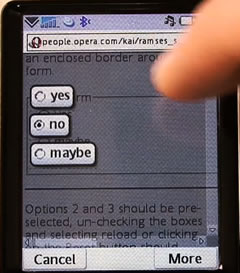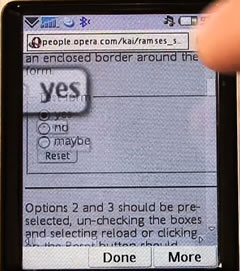Here's a quick run though of how Fingertouch works in practise:



- User clicks on a part of the page, but due to closely spaced elements, it tricky to select the 'right' element.
- Opera Fingertouch 'zooms in' on the page elements in question making it easier to select the 'right' one.
- Visual confirmation of the 'right' element is provided by having it 'fly' towards the user.
Fingertouch is a very interesting idea and, on certain types of devices, it could make a very significant difference to the browsing experience. While some may question the concept because it adds an additional interaction step, I think this would be an acceptable trade off for guaranteed accuracy. Moreover it is much more efficient than having to manually zoom in and out (probably the more typical current usage scenario).
I would not be at all suprised to see this idea replicated in other mobile browsers in the near future. You can read more about Fingertouch in this Opera Labs article.
Here's a video, which offers the best way to grasp this concept, showing the Fingertouch technology being demoed on the Sony Ericsson P1i:
Currently Fingertouch has only been implemented in the beta version of Opera 9.5 for UIQ 3. However it is likely we will see it Opera 9.5 for other mobile platforms in due course.
Opera are currently working on the development on Opera 9.5 for S60 and a release is expected some time this year. We spoke to Opera at Mobile World Congress a few weeks ago, but they were unable to get any definitive information on a release date for the S60 platform. Opera's CEO, Jon von Tetzchne, said it was 'a work in progress'.
Opera's Widget Manager, which is available for S60 (albeit in beta form), is based on Opera 9.5 and gives you some indication of what Opera 9.5 on S60 will be like. Opera Widget Manager is well worth taking a look at in its own right; it is notable that it has been chosen by Vodafone as its widget platform for mobile devices.
